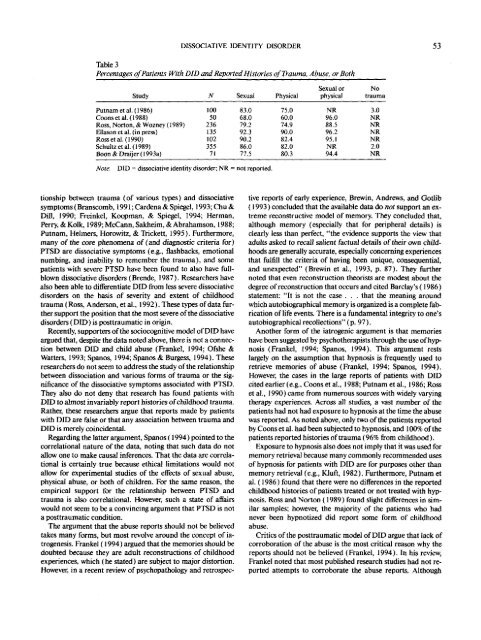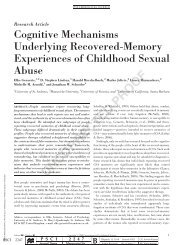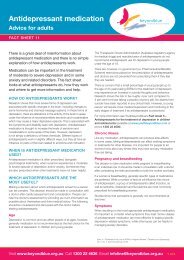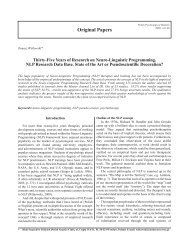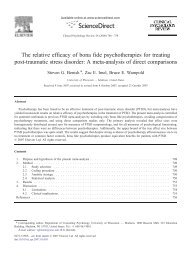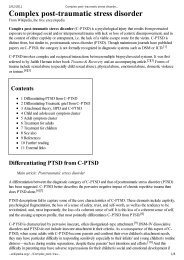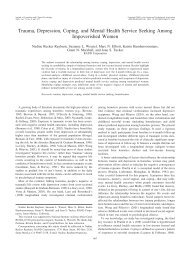The Sociocognitive Model of Dissociative Identity Disorder: A ...
The Sociocognitive Model of Dissociative Identity Disorder: A ...
The Sociocognitive Model of Dissociative Identity Disorder: A ...
You also want an ePaper? Increase the reach of your titles
YUMPU automatically turns print PDFs into web optimized ePapers that Google loves.
DISSOCIATIVE IDENTITY DISORDER 53<br />
Table 3<br />
Percentages <strong>of</strong> Patients With DID and Reported Histories <strong>of</strong> Trauma, Abuse, or Both<br />
Study<br />
N<br />
Sexual<br />
Physical<br />
Sexual or<br />
physical<br />
No<br />
trauma<br />
Putnam etal. (1986)<br />
Coons etal. (1988)<br />
Ross, Norton, & Wozney (1989)<br />
Ellason et al. (in press)<br />
Ross etal. (1990)<br />
Schultz etal. (1989)<br />
Boon & Draijer ( 1 993a)<br />
100<br />
50<br />
236<br />
135<br />
102<br />
355<br />
71<br />
83.0<br />
68.0<br />
79.2<br />
92.3<br />
90.2<br />
86.0<br />
77.5<br />
75.0<br />
60.0<br />
74.9<br />
90.0<br />
82.4<br />
82.0<br />
80.3<br />
NR<br />
96.0<br />
88.5<br />
96.2<br />
95.1<br />
NR<br />
94.4<br />
3.0<br />
NR<br />
NR<br />
NR<br />
NR<br />
2.0<br />
NR<br />
Note. DID = dissociative identity disorder; NR = not reported.<br />
tionship between trauma (<strong>of</strong> various types) and dissociative<br />
symptoms (Branscomb, 1991; Cardena & Spiegel, 1993; Chu &<br />
Dill, 1990; Freinkel, Koopman, & Spiegel, 1994; Herman,<br />
Perry,&Kolk, 1989;McCann,Sakheim,&Abrahamson, 1988;<br />
Putnam, Helmers, Horowitz, & Trickett, 1995). Furthermore,<br />
many <strong>of</strong> the core phenomena <strong>of</strong> (and diagnostic criteria for)<br />
PTSD are dissociative symptoms (e.g., flashbacks, emotional<br />
numbing, and inability to remember the trauma), and some<br />
patients with severe PTSD have been found to also have fullblown<br />
dissociative disorders (Brende, 1987). Researchers have<br />
also been able to differentiate DID from less severe dissociative<br />
disorders on the basis <strong>of</strong> severity and extent <strong>of</strong> childhood<br />
trauma (Ross, Anderson, et al., 1992). <strong>The</strong>se types <strong>of</strong> data further<br />
support the position that the most severe <strong>of</strong> the dissociative<br />
disorders (DID) is posttraumatic in origin.<br />
Recently, supporters <strong>of</strong> the sociocognitive model <strong>of</strong> DID have<br />
argued that, despite the data noted above, there is not a connection<br />
between DID and child abuse (Frankel, 1994; Ofshe &<br />
Walters, 1993;Spanos, 1994; Spanos & Burgess, 1994). <strong>The</strong>se<br />
researchers do not seem to address the study <strong>of</strong> the relationship<br />
between dissociation and various forms <strong>of</strong> trauma or the significance<br />
<strong>of</strong> the dissociative symptoms associated with PTSD.<br />
<strong>The</strong>y also do not deny that research has found patients with<br />
DID to almost invariably report histories <strong>of</strong> childhood trauma.<br />
Rather, these researchers argue that reports made by patients<br />
with DID are false or that any association between trauma and<br />
DID is merely coincidental.<br />
Regarding the latter argument, Spanos (1994) pointed to the<br />
correlational nature <strong>of</strong> the data, noting that such data do not<br />
allow one to make causal inferences. That the data are correlational<br />
is certainly true because ethical limitations would not<br />
allow for experimental studies <strong>of</strong> the effects <strong>of</strong> sexual abuse,<br />
physical abuse, or both <strong>of</strong> children. For the same reason, the<br />
empirical support for the relationship between PTSD and<br />
trauma is also correlational. However, such a state <strong>of</strong> affairs<br />
would not seem to be a convincing argument that PTSD is not<br />
a posttraumatic condition.<br />
<strong>The</strong> argument that the abuse reports should not be believed<br />
takes many forms, but most revolve around the concept <strong>of</strong> iatrogenesis.<br />
Frankel (1994) argued that the memories should be<br />
doubted because they are adult reconstructions <strong>of</strong> childhood<br />
experiences, which (he stated) are subject to major distortion.<br />
However, in a recent review <strong>of</strong> psychopathology and retrospective<br />
reports <strong>of</strong> early experience, Brewin, Andrews, and Gotlib<br />
(1993) concluded that the available data do not support an extreme<br />
reconstructive model <strong>of</strong> memory. <strong>The</strong>y concluded that,<br />
although memory (especially that for peripheral details) is<br />
clearly less than perfect, "the evidence supports the view that<br />
adults asked to recall salient factual details <strong>of</strong> their own childhoods<br />
are generally accurate, especially concerning experiences<br />
that fulfill the criteria <strong>of</strong> having been unique, consequential,<br />
and unexpected" (Brewin et al., 1993, p. 87). <strong>The</strong>y further<br />
noted that even reconstruction theorists are modest about the<br />
degree <strong>of</strong> reconstruction that occurs and cited Barclay's (1986)<br />
statement: "It is not the case . . . that the meaning around<br />
which autobiographical memory is organized is a complete fabrication<br />
<strong>of</strong> life events. <strong>The</strong>re is a fundamental integrity to one's<br />
autobiographical recollections" (p. 97).<br />
Another form <strong>of</strong> the iatrogenic argument is that memories<br />
have been suggested by psychotherapists through the use <strong>of</strong> hypnosis<br />
(Frankel, 1994; Spanos, 1994). This argument rests<br />
largely on the assumption that hypnosis is frequently used to<br />
retrieve memories <strong>of</strong> abuse (Frankel, 1994; Spanos, 1994).<br />
However, the cases in the large reports <strong>of</strong> patients with DID<br />
cited earlier (e.g., Coons et al., 1988; Putnam et al., 1986; Ross<br />
et al., 1990) came from numerous sources with widely varying<br />
therapy experiences. Across all studies, a vast number <strong>of</strong> the<br />
patients had not had exposure to hypnosis at the time the abuse<br />
was reported. As noted above, only two <strong>of</strong> the patients reported<br />
by Coons et al. had been subjected to hypnosis, and 100% <strong>of</strong> the<br />
patients reported histories <strong>of</strong> trauma (96% from childhood).<br />
Exposure to hypnosis also does not imply that it was used for<br />
memory retrieval because many commonly recommended uses<br />
<strong>of</strong> hypnosis for patients with DID are for purposes other than<br />
memory retrieval (e.g., Kluft, 1982). Furthermore, Putnam et<br />
al. (1986) found that there were no differences in the reported<br />
childhood histories <strong>of</strong> patients treated or not treated with hypnosis.<br />
Ross and Norton (1989) found slight differences in similar<br />
samples; however, the majority <strong>of</strong> the patients who had<br />
never been hypnotized did report some form <strong>of</strong> childhood<br />
abuse.<br />
Critics <strong>of</strong> the posttraumatic model <strong>of</strong> DID argue that lack <strong>of</strong><br />
corroboration <strong>of</strong> the abuse is the most critical reason why the<br />
reports should not be believed (Frankel, 1994). In his review,<br />
Frankel noted that most published research studies had not reported<br />
attempts to corroborate the abuse reports. Although


